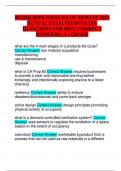Exam (elaborations)
NCIDQ IDPX FINAL EXAM NEWEST 2024 ACTUAL EXAM STUDYGUIDE QUESTIONS AND 100% CORRECT ANSWERS | A+ GRADE
- Course
- Institution
NCIDQ IDPX FINAL EXAM NEWEST 2024 ACTUAL EXAM STUDYGUIDE QUESTIONS AND 100% CORRECT ANSWERS | A+ GRADE
[Show more]



